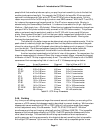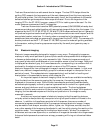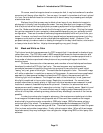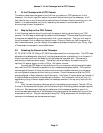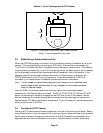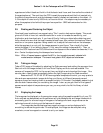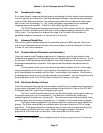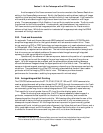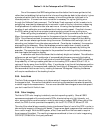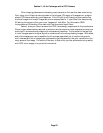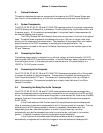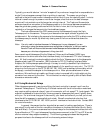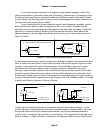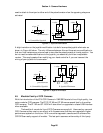
Section 3 - At the Telescope with a CCD Camera
Page 19
3.8. Processing the Image
If not done already, images can be improved by subtracting off a dark frame of equal exposure.
You will typically do this as part of the Grab command although it can also be done manually
using the Dark Subtract command. By subtracting the dark frame, pixels which have higher
dark current than the average, i.e., "hot" pixels, are greatly suppressed and the displayed
image appears much smoother. Visibility of faint detail is greatly improved.
The CCDOPS program also supports the use of flat field frames to correct for vignetting
and pixel to pixel variations, as well as a host of other image processing commands in the
Utility menu. You can smooth or sharpen the image, flip it to match the orientation of
published images for comparison, or remove hot or cold pixels.
3.9. Advanced Capabilities
The following sections describe some of the advanced features of SBIG cameras. While you
may not use these features the first night, they are available and a brief description of them is
in order for your future reference.
3.9.1. Crosshairs Mode (Photometry and Astrometry)
Using the crosshair mode
3
enables examination of images on a pixel by pixel basis for such
measurements as Stellar and Diffuse Magnitude, and measurement of stellar positions. The 16
bit accuracy of SBIG systems produces beautiful low-noise images and allows very accurate
brightness measurements to be made. With appropriate filters stellar temperature can be
measured.
In the crosshair mode, you move a small cross shaped crosshair around in the image
using the keyboard or the mouse. As you position the crosshair, the software displays the
pixel value beneath the crosshair and the X and Y coordinates of the crosshair. Also shown is
the average pixel value for a box of pixels centered on the crosshair. You can change the size of
the averaging box from 3x3 to 31x31 pixels to collect all the energy from a star.
3.9.2. Sub-Frame Readout in Focus
The Focus command offers several frame modes for flexibility and increased frame throughput.
As previously discussed, the Full frame mode shows the entire field of view of the CCD with
the highest resolution, digitizing and displaying all pixels.
The "Dim" mode offers the same field of view but offers higher frame rates by reducing
the image's resolution prior to downloading. The resolution is reduced by combining a
neighboring block of pixels into a "super pixel". This reduces the download and display times
proportionately, as well as improving sensitivity. It is great for finding and centering objects.
The Planet mode is suggested if high spatial resolution is desired for small objects like
planets. The Planet mode allows you to select a small sub-area of the entire CCD for image
acquisition. The highest resolution is maintained but you don't have to waste time digitizing
and processing pixels that you don't need. Again, the image throughput increase is
proportional to the reduction in frame size. It can be entered from Auto mode.
3
Under DOS the Crosshairs mode is accessed through the Display Image command in the Analysis
mode.



